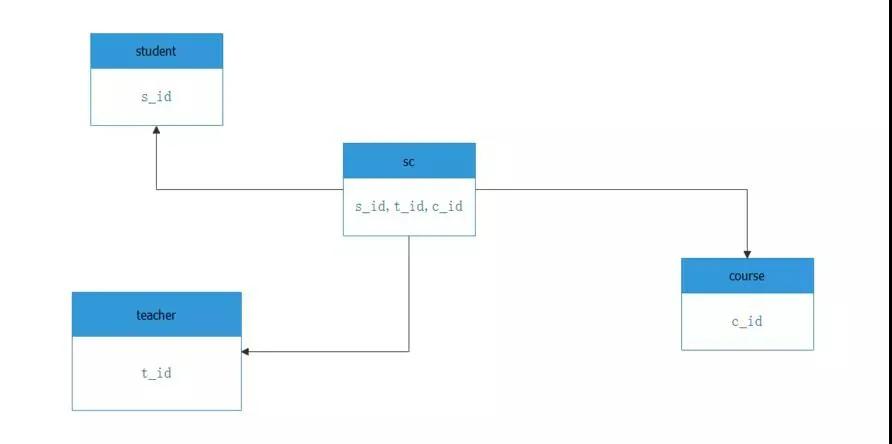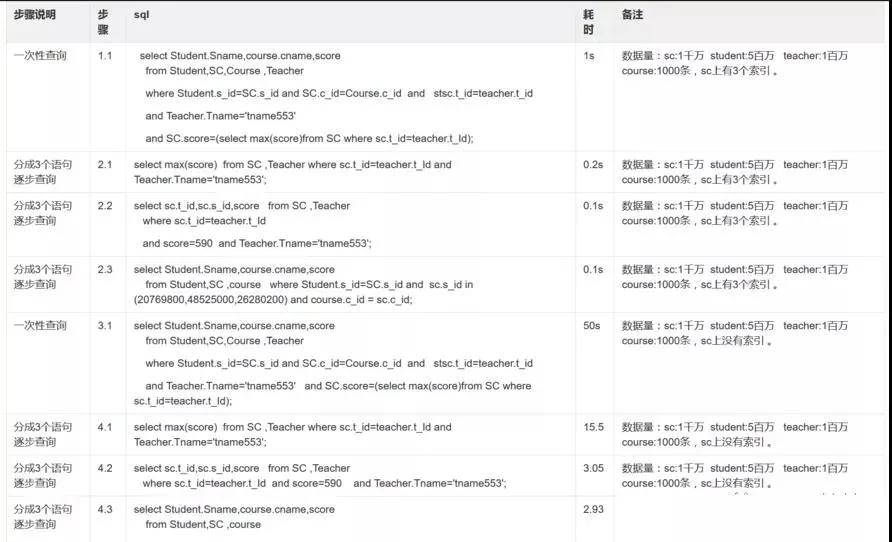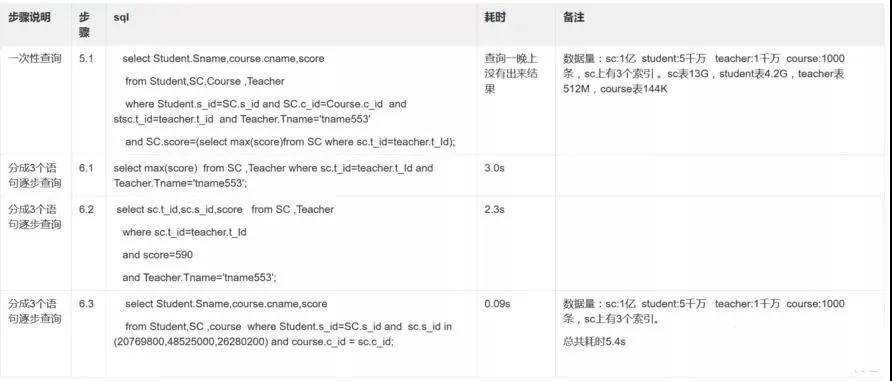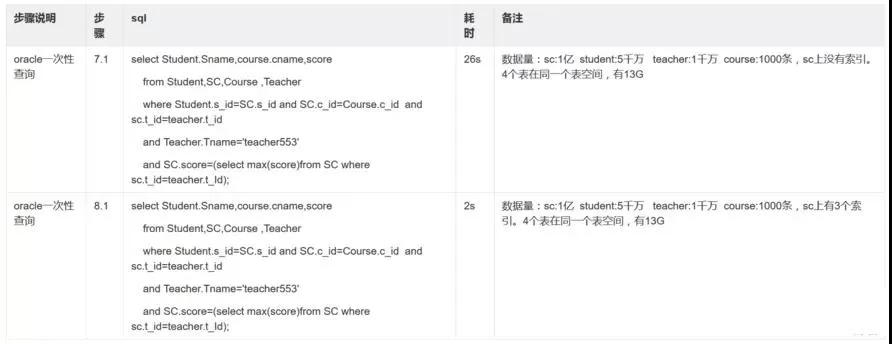图片来自 包图网
问题分析
对这个结论,你是否有怀疑呢?也不知道是哪位先哲说的不要人云亦云,今天我设计 sql,来验证这个结论。(实验没有从代码角度分析,目前达不到。可以把 MySQL 当一个黑盒,使用角度来验证这个结论)
验证结论的时候,会有很多发现,各位往后看。
实验环境
VMware 10+Centos 7.4+MySQL 5.7.22 ,Centos 7 内存 4.5G,4 核,50G 硬盘。MySQL 配置为 2G,特别说明硬盘是 SSD。
我的实验
有 4 张表,student 学生表,teacher 老师表,course 课程表,sc 中间关系表,记录了学生选修课程以及分数。
具体 sql 脚本,看文章结尾,我附上。中间我自己写了造数据的脚本,也在结尾。
实验是为解决一个问题的:查询选修“tname553”老师所授课程的学生中,成绩最高的学生姓名及其成绩 。
查询 sql 是:
- select Student.Sname,course.cname,score
- from Student,SC,Course ,Teacher
- where Student.s_id=SC.s_id and SC.c_id=Course.c_id and sc.t_id=teacher.t_id
- and Teacher.Tname='tname553'
- and SC.score=(select max(score)from SC where sc.t_id=teacher.t_Id);
我来分析一下这个语句:4 张表等值 join,还有一个子查询。算是比较简单的 sql 语句了(相比 ERP 动就 10 张表的哦,已经很简单了)。
我还会分解这个语句成 3 个简单的 sql:
- select max(score) from SC ,Teacher where sc.t_id=teacher.t_Id and Teacher.Tname='tname553';
- select sc.t_id,sc.s_id,score from SC ,Teacher
- where sc.t_id=teacher.t_Id
- and score=590
- and Teacher.Tname='tname553';
- select Student.Sname,course.cname,score
- from Student,SC ,course
- where Student.s_id=SC.s_id and sc.s_id in (20769800,48525000,26280200) and course.c_id = sc.c_id;
我来分析下:第一句,就是查询最高分,得到最高分 590 分。第二句就是查询出最高分的学生 id,得到:
- 20769800,48525000,26280200
第三句就是查询出学生名字和分数。这样这 3 个语句的就可以查询出来成绩最高的学生姓名及其成绩。
接下来我会分别造数据:1 千万选课记录(一个学生选修 2 门课),造 500 万学生,100 万老师(一个老师带 5 个学生,挺高端的吧),1000 门课。
用上面查询语句查询。其中 sc 表我测试了下有索引和没有索引情况,具体见下表。
再接下来,我会造 1 亿选课记录(一个学生选修 2 门课)5000 万学生,1000 万老师,1000 门课。然后分别执行上述语句。最后我会在 oracle 数据库上执行上述语句。
下面两张表是测试结果:
仔细看上表,可以发现?
①步骤 3.1 没有在连接键上加索引,查询很慢,说明:“多表关联查询时,保证被关联的字段需要有索引”。
②步骤 6.1,6.2,6.3,换成简单 sql,在数据量 1 亿以上, 查询时间还能勉强接受。此时说明 MySQL 查询有些吃力了,但是仍然嫩查询出来。
③步骤 5.1,MySQL 查询不出来,4 表连接,对我本机 MySQL 来说,1.5 亿数据超过极限了(我调优过这个 SQL,执行计划和索引都走了,没有问题,show profile 显示在 sending data,这个问题另外文章详谈)。
④对比 1.1 和 5.1 步骤 sql 查询,4 表连接,对我本机 MySQL 来说 ,1.5 千万数据查询很流利,是一个 MySQL 数据量流利分水岭。(这个只是现象,不太准确,需要同时计算表的容量)。
⑤步骤 5.1 对比 6.1,6.2,6.3,多表 join 对 MySQL 来说,处理有些吃力。
⑥超过三张表禁止 join,这个规则是针对 MySQL 来说的。后续会看到我用同样机器,同样数据量,同样内存,可以完美计算 1.5 亿数据量 join。
针对这样一个规则,对开发来说 ,需要把一些逻辑放到应用层去查询。
总结:这个规则,超过三张表禁止 join,由于数据量太大的时候,MySQL 根本查询不出来,导致阿里出了这样一个规定。
其实如果表数据量少,10 张表也不成问题,你自己可以试试。而我们公司支付系统朝着大规模高并发目标设计的,所以,遵循这个规定。
在业务层面来讲,写简单 sql,把更多逻辑放到应用层,我的需求我会更了解,在应用层实现特定的 join 也容易得多。
让我们来看看 oracle 数据库的优秀表现:
看步骤 7.1,就是没有索引,join 表很多的情况下,oracle 仍然 26 秒查询出结果来。所以我会说 MySQL 的 join 很弱。
那么问题来了,为什么现在使用很多人使用 MySQL 呢?这是另外一个问题,我会另外说下我的思考。
看完本篇文章,另外我还附加赠送,所谓搂草打兔子。就是快速造数据。你可以自己先写脚本造数据,看看我是怎么造数据的,就知道我的技巧了。
附上部分截图:
附上 sql 语句和造数据脚本:
- use stu;
- drop table if exists student;
- create table student
- ( s_id int(11) not null auto_increment ,
- sno int(11),
- sname varchar(50),
- sage int(11),
- ssex varchar(8) ,
- father_id int(11),
- mather_id int(11),
- note varchar(500),
- primary key (s_id),
- unique key uk_sno (sno)
- ) engine=innodb default charset=utf8mb4;
- truncate table student;
- delimiter $$
- drop function if exists insert_student_data $$
- create function insert_student_data()
- returns int deterministic
- begin
- declare i int;
- set i=1;
- while i<50000000 do
- insert into student values(i ,i, concat('name',i),i,case when floor(rand()*10)%2=0 then 'f' else 'm' end,floor(rand()*100000),floor(rand()*1000000),concat('note',i) );
- set i=i+1;
- end while;
- return 1;
- end$$
- delimiter ;
- select insert_student_data();
- select count(*) from student;
- use stu;
- create table course
- (
- c_id int(11) not null auto_increment ,
- cname varchar(50)
- note varchar(500), primary key (c_id)
- ) engine=innodb default charset=utf8mb4;
- truncate table course;
- delimiter $$
- drop function if exists insert_course_data $$
- create function insert_course_data()
- returns int deterministic
- begin
- declare i int;
- set i=1;
- while i<=1000 do
- insert into course values(i , concat('course',i),floor(rand()*1000),concat('note',i) );
- set i=i+1;
- end while;
- return 1;
- end$$
- delimiter ;
- select insert_course_data();
- select count(*) from course;
- use stu;
- drop table if exists sc;
- create table sc
- (
- s_id int(11),
- c_id int(11),
- t_id int(11),
- score int(11)
- ) engine=innodb default charset=utf8mb4;
- truncate table sc;
- delimiter $$
- drop function if exists insert_sc_data $$
- create function insert_sc_data()
- returns int deterministic
- begin
- declare i int;
- set i=1;
- while i<=50000000 do
- insert into sc values( i,floor(rand()*1000),floor(rand()*10000000),floor(rand()*750)) ;
- set i=i+1;
- end while;
- return 1;
- end$$
- delimiter ;
- select insert_sc_data();
- commit;
- select insert_sc_data();
- commit;
- create index idx_s_id on sc(s_id) ;
- create index idx_t_id on sc(t_id) ;
- create index idx_c_id on sc(c_id) ;
- select count(*) from sc;
- use stu;
- drop table if exists teacher;
- create table teacher
- (
- t_id int(11) not null auto_increment ,
- tname varchar(50) ,
- note varchar(500),primary key (t_id)
- ) engine=innodb default charset=utf8mb4;
- truncate table teacher;
- delimiter $$
- drop function if exists insert_teacher_data $$
- create function insert_teacher_data()
- returns int deterministic
- begin
- declare i int;
- set i=1;
- while i<=10000000 do
- insert into teacher values(i , concat('tname',i),concat('note',i) );
- set i=i+1;
- end while;
- return 1;
- end$$
- delimiter ;
- select insert_teacher_data();
- commit;
- select count(*) from teacher;
这个是 oracle 的测试和造数据脚本:
- create tablespace scott_data datafile '/home/oracle/oracle_space/sitpay1/scott_data.dbf' size 1024m autoextend on;
- create tablespace scott_index datafile '/home/oracle/oracle_space/sitpay1/scott_index.dbf' size 64m autoextend on;
- create temporary tablespace scott_temp tempfile '/home/oracle/oracle_space/sitpay1/scott_temp.dbf' size 64m autoextend on;
- drop user scott cascade;
- create user scott identified by tiger default tablespace scott_data temporary tablespace scott_temp ;
- grant resource,connect,dba to scott;
- drop table student;
- create table student
- ( s_id number(11) ,
- sno number(11) ,
- sname varchar2(50),
- sage number(11),
- ssex varchar2(8) ,
- father_id number(11),
- mather_id number(11),
- note varchar2(500)
- ) nologging;
- truncate table student;
- create or replace procedure insert_student_data
- is
- q number(11);
- begin
- q:=0;
- for i in 1..50 loop
- insert /*+append*/ into student select rownum+q as s_id,rownum+q as sno, concat('sutdent',rownum+q ) as sname,floor(dbms_random.value(1,100)) as sage,'f' as ssex,rownum+q as father_id,rownum+q as mather_id,concat('note',rownum+q ) as note from dual connect by level<=1000000;
- q:=q+1000000;
- commit;
- end loop;
- end insert_student_data;
- /
- call insert_student_data();
- alter table student add constraint pk_student primary key (s_id);
- commit;
- select count(*) from student;
- create table course
- (
- c_id number(11) primary key,
- cname varchar2(50),
- note varchar2(500)
- ) ;
- truncate table course;
- create or replace procedure insert_course_data
- is
- q number(11);
- begin
- for i in 1..1000 loop
- insert /*+append*/ into course values(i , concat('name',i),concat('note',i) );
- end loop;
- end insert_course_data;
- /
- call insert_course_data();
- commit;
- select count(*) from course;
- create table sc
- (
- s_id number(11),
- c_id number(11),
- t_id number(11),
- score number(11)
- ) nologging;
- truncate table sc;
- create or replace procedure insert_sc_data
- is
- q number(11);
- begin
- q:=0;
- for i in 1..50 loop
- insert /*+append*/ into sc select rownum+q as s_id, floor(dbms_random.value(0,1000)) as c_id,floor(dbms_random.value(0,10000000)) t_id,floor(dbms_random.value(0,750)) as score from dual connect by level<=1000000;
- q:=q+1000000;
- commit;
- end loop;
- end insert_sc_data;
- /
- call insert_sc_data();
- create index idx_s_id on sc(s_id) ;
- create index idx_t_id on sc(t_id) ;
- create index idx_c_id on sc(c_id) ;
- select count(*) from sc;
- create table teacher
- (
- t_id number(11) ,
- tname varchar2(50) ,
- note varchar2(500)
- )nologging ;
- truncate table teacher;
- create or replace procedure insert_teacher_data
- is
- q number(11);
- begin
- q:=0;
- for i in 1..10 loop
- insert /*+append*/ into teacher select rownum+q as t_id, concat('teacher',rownum+q ) as tname,concat('note',rownum+q ) as note from dual connect by level<=1000000;
- q:=q+1000000;
- commit;
- end loop;
- end insert_teacher_data;
- /
- call insert_teacher_data();
- alter table teacher add constraint pk_teacher primary key (t_id);
- select count(*) from teacher;
作者:e71hao
编辑:陶家龙
出处:blog.itpub.net/30393770/viewspace-2650450/










































